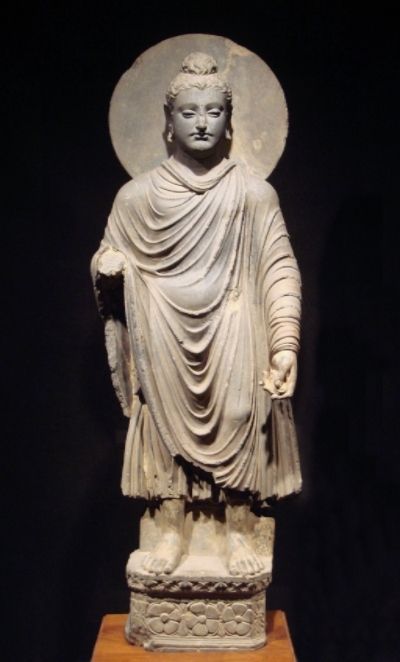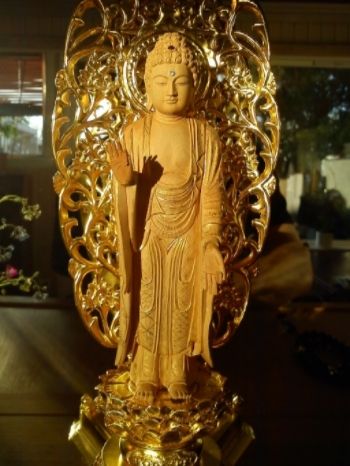FEATURES|THEMES|General
The Body of the Buddha: A Conversion Story
It sometimes takes many years to understand the significance of life events. My journey into Buddhism began with an afternoon spent in an art museum when I was a teenager. However, it was not until many years later, when I discovered a mystery at the heart of early Buddhism, that I began to think of this encounter with Buddhist art as something more than ordinary. Though I can hardly imagine Buddhism without representations of the Buddha, I was surprised to learn recently that there were no images of the historical Buddha produced until some three to four centuries after his passing. Quite unexpectedly, this question of images became pivotal in tracing the arc of my entry into the Dharma.
Many scholars have suggested that the Buddha himself proscribed the fashioning and veneration of his image, but there is no clear scriptural evidence for this.* Indeed, given the trust the Buddha placed in his sangha to self-govern without an appointed successor after his passing, it becomes hard to muster an image of him issuing such a strict prohibition to his soon-to-be orphaned community. While relic worship played an early and important role in both lay and monastic Buddhist devotion (Chan 2013, 22–26), the practices of prostrating or making offerings before a statue of the Buddha were, by modern standards, conspicuously lacking. Perhaps depicting one who had attained nirvana (and thus transcending all human categories) was inappropriate. If this was the case, what must have begun as a gesture of respect quickly crystallized into a universally observed taboo against depicting the Buddha in human form. Only indirect and suggestive symbolism was used: a Bodhi tree; a footprint; a Dharma wheel.*
Then, like the deluge after a drought, something changed; around the beginning of the Common Era, statues of the Buddha began to appear. Probably, the earliest images were produced either in Gandhara (situated astride the present-day Afghanistan-Pakistan border) or in Mathura (north-central India) (Sanujit 2011). In Gandhara, it seems that one factor influencing the development of Buddhist art was Greek culture.** As the descendants of Alexander the Great’s armies began to embrace the Buddha’s teaching, they produced—or induced the sangha to sponsor the production of—legions of very Apollo-like statues of the Buddha. The taboo was broken, and a new way of encountering the Buddha was initiated.
I think it is significant that this artistic development coincided roughly with the emergence of the early Mahayana, a movement which, according to Paul Williams, employed the practice of meditatively visualizing enjoyment-body Buddhas in their pure lands (Williams 2009, 39–44). Sustained practice would often result in a dream or visionary encounter with the Buddha, in which the practitioner might receive new teachings. For the meditators who encountered them, these enjoyment bodies most fully revealed the transcendent and exalted nature of the Buddhas, for these were not bodies of gross matter; they were bodies of purity and light, manifesting the unending bliss of Dharma nature. To what degree the artistic and mystical spheres of Buddhist activity influenced each other during this period is unclear; what is clear is that the body of the Buddha was once more available to his community to be venerated and showered with offerings—both as an object of meditation, and as an object of art.
My entry into this story comes some two millennia later. My first encounter with Buddhism takes place when I walk through the doors of the Freer Gallery of Art at the Smithsonian Institute in Washington, D.C. They are holding an exhibition featuring the Mahayana Buddhism of East Asia, and the body of the Buddha is everywhere. I am spellbound. There is a sublime, otherworldly feel to the motifs. Though I cannot articulate it at the time, I understand that this is not the Buddha of history, but of revelation; for this is an archetype of perfection and transcendence. He sits or stands on a golden lotus, often with a flaming nimbus framing his head and body. His skin is golden, and his hair lays in rows of symmetrical curls. His posture radiates calm and serenity. He is beautiful, but also mysterious: what is that strange bump on the crown of his head? (Hair? Brains?) The “dot” or urna on his brow (representing a tuft of hair) is curious. His dangling ears are likewise a mystery until I read on one of the exhibits that elongated earlobes signal the Buddha’s royal heritage, as Prince Siddhartha wore heavy golden earrings.
I look closer. With eyes half-closed in meditation, a half-smile (quarter-smile?) glances off the Buddha’s face like moonlight on water—there, yet never the same from moment to moment. He is of the realm of dreams and visions; omniscience possessed of personality and warmth; a light by which a lost traveler journeys home through the darkness. Unlike the central icons of my Christian heritage, there is no pain or agony depicted here, no appeal to fear or guilt, just an awakened being hailing from the far side of suffering and ignorance. He is not of the world, but neither does he condemn it. He is a beacon. A contradiction. A taboo broken.
As a teenager, I know nothing about Buddhism; I only know what I am seeing, and it is utterly compelling. After two hours, a voice on a loudspeaker announces that the museum will be closing in ten minutes. Immediately, I run downstairs to the gift shop and spend all the money I have on books about Buddhism. While I eventually read the books with enthusiasm (all titles by Thich Nhat Hanh, as I recall), the content of the books only underscores what I have already intuited through the exhibition: that the Buddha embodies the highest human ideals of wisdom, compassion and consciousness, and that his teaching will help us, over time, to realize these same qualities.
Looking back at the trajectory my life has taken since this incident, I now feel justified in calling that afternoon in the Freer Gallery a “conversion experience.” For me, as I believe it was for many in the Buddha’s own day, my conversion to Buddhism was not primarily intellectual; it was the result of an encounter. Before I had learned the Dharma or practiced any teaching, I was converted based upon a “vision” of the Buddha.
Here can be found the roots of my Mahayanist tendencies. For the early Mahayanists, the Buddha was not just a pathfinder, an example to be emulated and revered, but also a living presence who was both accessible and constantly teaching the Dharma. For those meditators who had the requisite skill, the path inward to that celestial Vulture Peak where the supramundane Buddha would discourse on the Mahayana was arduous and long. Probably not many were capable of walking it, but those who were certainly came back transformed by the experience. I suspect that the early visualization practices did influence, and perhaps even catalyze, the artistic imperative to depict the Buddha’s body. As the Mahayana is a spiritual system that recognizes innumerable skillful means, the sangha could well have seen it as an act of compassion to break with tradition and taboo and bestow a vision of the Buddha, in the form of statues and images, on those simple followers who could not encounter him in meditation. I can only believe that this furthered the spread of Buddhism among the laity, who could now personally encounter the Tathagata on the temple altar just as I encountered him at the Freer Gallery.
Throughout history, faith and devotion—exemplified by, among other things, the veneration of images—have spiritually nourished as many Buddhists as have meditation and rituals, if not more. My own Buddhist journey has led me through the rigors of Zen to the devotion-centered practice of Pure Land Buddhism. Building my own shrine room became an important part of manifesting my devotion to Amitabha Buddha, and it continues to be a place where my practice of reciting the Buddha’s name finds grounding and strength. Importantly, the Buddha image enshrined on my altar reminds me of that first encounter at the Freer Gallery. When gazing on Amitabha’s image, his light and compassion are able to light up the darkest corners of my life, and I remember that his attainments are not beyond my reach.
Because of my Mahayanist orientation, it may be that the Buddhism I practice would be unrecognized as such by the first generations of the Buddha’s disciples (who could not even gaze upon the Buddha’s image at the original stupas housing his cremains). Lest we assume that all the forms of Buddhist practice we see today trace back to the time of the historical Buddha, it is important to remember that some of the things we take most for granted, like making obeisance before a statue of the Buddha, were once unheard of. Perhaps the genius of Buddhism has been its ability to adapt, to reformulate the Dharma in ways both simple and complex, and to transform the rubble of a broken taboo into the seeds of faith for new generations.
*Dharma Data: Buddha Statues
**Gandhara
References
Chan Khoon San. 2013. “Shrines and Relics in Buddhism.” http://www.urbandharma.org/pdf1/01Shrines.pdf.
Sanujit. 2011. “Cultural Links between India and the Greco-Roman World.” http://www.ancient.eu/article/208/.
Williams, Paul. 2009. Mahayana Buddhism: The Doctrinal Foundations. New York: Routledge.
This article is one of a series on how Buddhism has impacted the lives of practitioners. We welcome you to send us your story as well. Write to info@buddhistdoor.com.
















